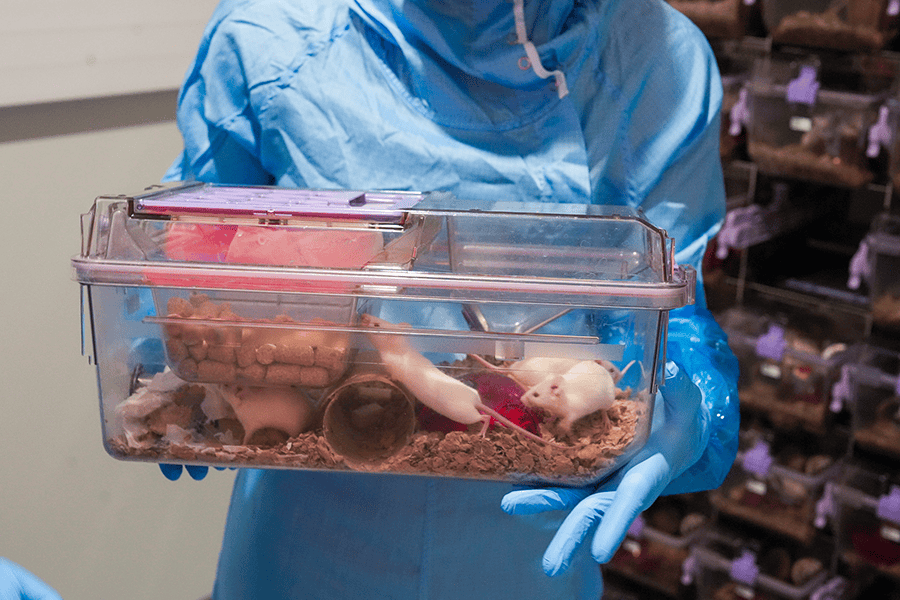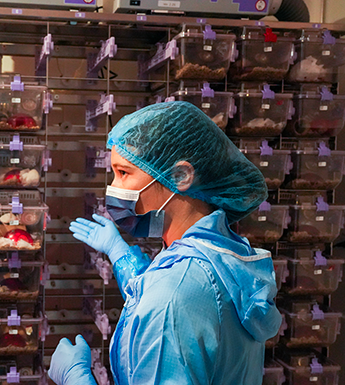Solenn Percelay, can you introduce yourself and tell us about your job?
Since 2022, I have been working as an Animal Welfare Scientist at TransCure bioServices. This role, similar to that known internationally as Animal Welfare Officer (AWO), is still relatively uncommon in France, but is essential for ensuring the welfare of animals in preclinical research. My goal is to reconcile scientific requirements with the working hours of researchers and animal technicians, while adopting an ethical and respectful approach to animals.
Before joining TransCure bioServices, I completed a thesis in neuroscience at the University of Caen on a mice model of schizophrenia, then held a position as an assistant professor at the Faculty of Pharmacy. These experiences have enabled me to acquire solid scientific expertise, which I now apply in my work. At TransCure bioServices, a CRO (Contract Research Organization) specializing in humanized mouse models, we work mainly on oncology, as well as inflammatory and infectious diseases such as HIV (AIDS virus), hepatitis, and fibrosis. With nearly 3,000 mice, my role is to ensure their well-being while meeting the scientific needs and expectations of our clients. I spend about 50% of my time on tasks directly related to animal welfare. These tasks are varied and constantly evolving to adapt to the needs of our organization.
What is your daily routine like when it comes to animal welfare?
A significant part of my work involves designing and implementing methods for assessing the welfare of mice. This involves analyzing their behavior, environment, and physiology. For example, we use behavioral testing devices such as the open field to assess their exploratory capacity and the dark/light box to assess anxiety, ethograms that quantify interactions with other mice or with enrichment, and anhedonia tests that detect loss of pleasure, a symptom associated with depression, through the consumption of sugar water. I pay close attention to anything that could influence animal welfare: light, noise, vibrations, etc. For example, we have set up a simple monitoring system to observe the activity of mice cage by cage in order to assess whether they are disturbed by certain external factors. We are also considering other approaches, such as measuring heart rate or preference tests (between two types of bedding, enrichment, or food, for example) using two interconnected cages. These methods are non-invasive and minimize stress for the animals. In some cases, we also measure physiological parameters such as corticosterone (a stress hormone in mice, equivalent to cortisol in humans) in hair, feces, or urine.
This data allows us to concretely evaluate the impact of procedures or environmental changes on the well-being of mice, and to validate decisions: changes in diet, in the amount of bedding, in the frequency of cage cleaning, the introduction of treats (sunflower seeds), the selection of enrichments such as cardboard tunnels or plastic domes to improve their environment... or even the adoption of new handling methods such as "cup handling," which consists of handling mice without picking them up by the tail, a less stressful method for them. The goal is to ensure that these adjustments are at least neutral, if not beneficial, for the animals, scientific ethics, and handlers. Controlling stress and pain during breeding and experimentation, which are significant sources of variability and physiological changes, is also a decisive step forward in strengthening the reliability and reproducibility of scientific data.

How do you share these advances and change animal research practices?
I help develop a Culture of Care by raising awareness among my colleagues about animal welfare issues. As head of the local Animal Welfare Unit, I participate in the drafting and continuous improvement of internal procedures. For example, we regularly discuss practices such as blood sampling (which route to use for which volume, for example between the saphenous and mandibular veins) or the administration of substances (guided by micropipette - MDA - for example) in order to identify the least invasive and most appropriate methods.
Another important part of my job is to promote transparency in animal experimentation. In particular, I write open articles and protocols, which are available on FRIA, to explain our approach and our progress, and share them as widely as possible, to support everyone in their thinking and practice, but also to help them address the subject. My role is constantly evolving according to needs, and every day is an opportunity to propose new ideas and test innovative approaches to improve animal welfare. For me, this is an essential responsibility that must be integrated into the very heart of scientific research. It's an exciting challenge that motivates me every day!


